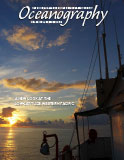Article Abstract
The Kuroshio is important to climate, weather prediction, and fishery management along the northeast coast of Asia because it transports tremendous heat, salt, and energy from east of the Philippines to waters southeast of Japan. In the middle of its journey northward, the Kuroshio’s velocity mean and its variability east of Taiwan crucially affect its downstream variability. To improve understanding of the Kuroshio there, multiple platforms were used to collect intensive observations off Taiwan during the three-year Observations of the Kuroshio Transports and their Variability (OKTV) program (2012–2015). Mean Kuroshio velocity transects show two velocity maxima southeast of Taiwan, with the primary velocity core on the onshore side of the Kuroshio exhibiting a mean maximum velocity of ~1.2 m s–1. The two cores then merge and move at a single velocity maximum of ~1 m s–1 east of Taiwan. Standard deviations of both the directly measured poleward (v) and zonal (u) velocities are ~0.4 m s–1 in the Kuroshio main stream. Water mass exchange in the Kuroshio east of Taiwan was found to be complicated, as it includes water of Kuroshio origin, South China Sea Water, and West Philippine Sea Water, and it vitally affects heat, salt, and nutrient inputs to the East China Sea. Impinging eddies and typhoons are two of the principal causes of variability in the Kuroshio. This study’s models are more consistent with the observed Kuroshio than with high-frequency radar measurements.

